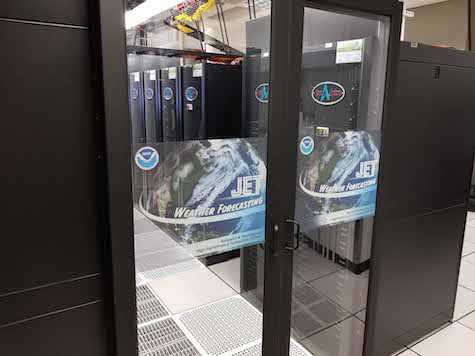High-Performance Computing

High-Performance Computing
GSL researches and hosts efficient high-performance computing to support NOAA’s mission.
High-Performance Computing (HPC) is critical for data assimilation and numerical weather prediction research
 A supercomputing legacy
A supercomputing legacy
The six supercomputers located within NOAA Boulder are collectively known as "Jet" and are managed by the NOAA Global Systems Laboratory. Jet provides about 30% of weather research and development computing in NOAA. Many NOAA High Performance Computing architecture improvements were first explored on Jet and are now standardized across NOAA. Jet is an important resource for NOAA's HPC national computing portolio, specifically in Colorado.
Energy-wise facility
NOAA Boulder’s Jet is the only NOAA research and development supercomputing location recognized as one of five NOAA Trusted Internet Connections, part of the mandate from the Office of Management and Budget to limit the number of gateways to the Internet on a government network. Jet is also an NWAVE core site and is housed in an Energy Star-rated building. The 2,060-square-foot award-winning computing facility can handle its rigorous environmental and electrical demands. State-of-the-art ambient air cooling and a clean-agent fire protection system, as well as many sophisticated facility environment monitoring and control safeguards, add up to a highly reliable and resilient center while enjoying the lowest Operation and Maintenance and System Support costs across all HPC supercomputing.
Research & development projects on Jet
The Jet system is funded solely by the Hurricane Forecast Improvement Program (HFIP) and is the only resource that accommodates reservations, a requirement during hurricane season. Other NOAA laboratories use Jet to advance their research in addition to users such as the National Hurricane Center, National Environmental Satellite, Data, and Information Service (NESDIS), the National Center for Atmospheric Research, and 12 universities.
With Jet located at NOAA Boulder, the data center is leveraged for quick and easy access to datasets that are needed for executing real-time experimental model runs and allows extensive testing of high-priority research to operations projects necessary for a transition into NOAA National Weather Service operations. Jet enabled the multi-year demonstration of GSL’s Rapid Refresh (RAP) and High-Resolution Rapid Refresh (HRRR) system that was implemented in operations as the first hourly-updating storm-scale numerical weather prediction model serving the lower 48 states. This research also included developing the HRRR Smoke model used widely by the NOAA National Weather Service, emergency managers, and air quality agencies. The experimental Hourly Wildfire Potential index is being developed on Jet, along with experimental prototype versions of the next-generation Rapid Refresh Forecast System (RRFS) for evaluation in NOAA testbed experiments.
A critical need to boost computing capacity
As the complexity of weather models increases, current NOAA HPC resources are not keeping up with the needs of our researchers. To date, NOAA has only a fraction of the computing capabilities required to fulfill its mission. In December 2021 NOAA’s Science Advisory Board released their report that suggests NOAA needs “at least a 100-times increase” in computing power over the coming decade to realize the potential of new models and address an imbalance between computing resources available to communities engaged in weather research versus operational forecasting. “Without increased computing resources, none of the recommended new models and data assimilation that improve the forecasts will be able to run on time,” it warns.
In 2014 a GSL researcher was awarded the Department of Commerce Bronze medal for dedication to acquiring supercomputing services to sustain the production of the Nation’s operational numerical weather and climate forecast systems.
